For a preview, this post will be featuring rooibos, red raspberry leaf, and New Jersey tea.
There is a significant demand for decaffeinated tea. RateTea currently lists 231 decaf teas, around 3.5% of the 6600+ teas in the database. (This figure only includes true teas that have been decaffeinated–not herbal teas that are naturally caffeine free.) And Google Trends shows that the search interest in decaf tea is on the rise, with a spike that coincides with the interest in green tea, which I wrote about on SpontaneiTea recently.
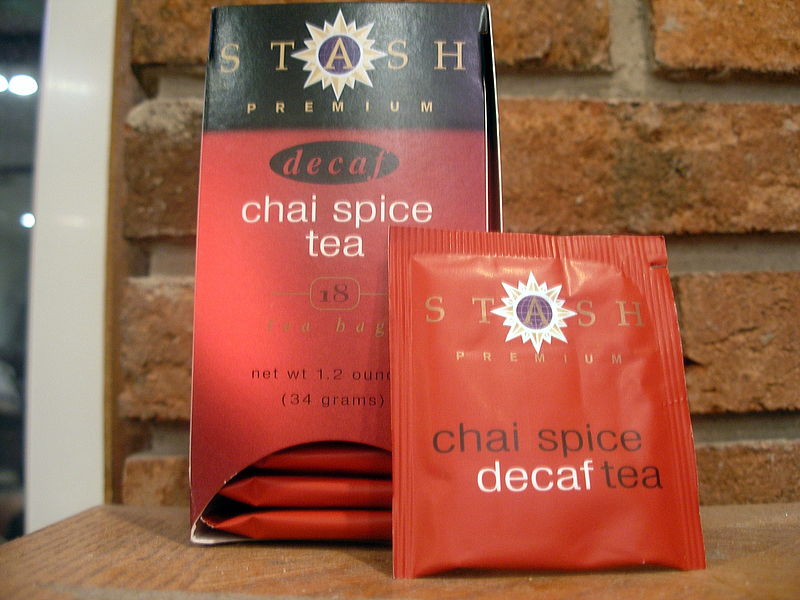
Decaffeinated flavored or spiced teas, like this “chai spice tea” sold by Stash, often taste better than pure decaf teas, because the additional flavorings can be added after the decaffeination process removes much of the flavor from the tea. Photo by JHoltzman, licensed under CC BY-SA 3.0.
On a personal level, I understand and relate to the desire for drinking decaf, at least in the abstract. I love tea, and I frequently drink enough of it that I don’t want any more, not because I tire of the taste or experience of drinking it, but rather, because I can only handle so much caffeine. Different people have different sensitivities to caffeine, and I find that I tend to be pretty sensitive to it. Tea festivals and trade shows like World Tea East or the Philadelphia Coffee and Tea Festival often put me in a bind–I want to keep sampling teas, but because I get so caffeinated, I turn down all but those I feel pretty sure I’ll like, and I’ve learned to pace myself with respect to the caffeine. So I understand how someone could want to drink tea without caffeine.
But decaf tea never satisfies me. In fact, more often than not, I think it tastes quite terrible, and I’d rather drink nothing or water than drink it. I’ve poured out many a decaf tea, brewing it only to find that it doesn’t even taste drinkable to me. Even the best decaf teas, to me, are ones that I dislike less rather than ones I truly love. Yet there is no shortage of naturally caffeine-free herbal teas that I enjoy.
There are also other reasons to avoid drinking decaf tea. One is health, and another is resource usage, which is related to sustainability. In this post, I will explore some of the reasons to drink naturally caffeine-free herbs rather than decaf tea, and I will give examples of the herbs that I think make the best tea substitutes.
Why Avoid Decaffeinated Tea? Health and Sustainability
Health and Safety Issues: Toxicity and Carcinogenicity
Decaffeination processes for coffee and tea have come a long way in terms of health and safety. Can you believe that benzene used to be used in decaffeination (for coffee, not tea)? Benzene is a major carcinogen and one of the most dangerous chemicals out there, in large part because it is both highly volatile and odorless. One of my relatives, a non-smoker, was an artist and used benzene as a paint thinner, and died of lung cancer. Thankfully, our society woke up to the dangers of this chemical long ago, and it has not been in use in decaffeination for years.
If you want to learn more in-depth about the decaffeination processes, both current and historic, used to remove the caffeine from tea, I recommend reading RateTea’s article on decaffeinated tea. Although there are a few esoteric processes, most tea nowadays is decaffeinated by one of three processes: CO2 (Carbon Dioxide), ethyl acetate, and methylene chloride. I seriously doubt that decaf tea is going to kill or seriously harm anyone, but there have been some health and safety concerns associated with methylene chloride. The other two processes, from my research, are totally safe. Ethyl acetate sounds like a synthetic chemical, but it is a naturally occurring chemical, one that even occurs in tea leaf itself and may be an important (and pleasant) component of the fruity aroma of both tea and wine.
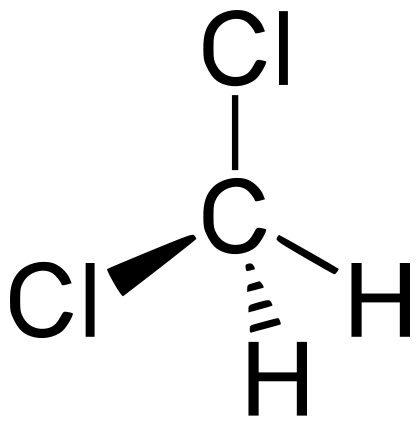
Methylene chloride or dichloromethane, a probable carcinogen and known liver toxin, is used in some decaffeination processes.
Methylene chloride, synonym dichloromethane, on the other hand, is a toxic chemical that shows some evidence of carcinogenicity. The use of this chemical is still legal in the United States. The EPA’s fact sheet on the chemical claims that the chemical does not harm the Ozone layer (unlike the fluorocarbons), but it can cause serious health problems, even at concentrations as low as 100 parts-per-million. Ingesting the chemical in a high enough dosage can cause liver problems, and the compound is classified as a probable carcinogen in humans, on the basis of it being a known carcinogen in animals.
Although the use of methylene chloride in decaffeination is regulated, I’m not convinced that it is always used within safe limits. I located one study which measured 15.9 parts-per-million of this chemical in a sample of commercially available decaffeinated tea. This is far higher than the allowable limit, and an amount that is enough to raise concerns about chronic/subchronic toxicity of the liver and possible carcinogenicity, especially in people who drink decaf tea regularly and in volume.
For this reason, I recommend for tea drinkers to avoid decaf tea where the decaffeination process is not identified as CO2, ethyl acetate, or another safe process. I also recommend for tea companies to phase out using methylene chloride, and for companies using safer processes to clearly identify which decaffeination process they do use, so that tea drinkers don’t overzealously avoid their products thinking they may be using the old methylene chloride process. As an example, Upton Tea Imports sells both CO2 and ethyl acetate decaf teas, and clearly identifies the process used on each tea.
Sustainability: Decaffeination is an Inefficient Production Process
From a resource usage standpoint, decaffeinated tea is extremely inefficient. Tea has been cultivated in large part because of its caffeine content, and many cultivars have been selected, in addition to their flavor, for their moderate-to-high caffeine content.
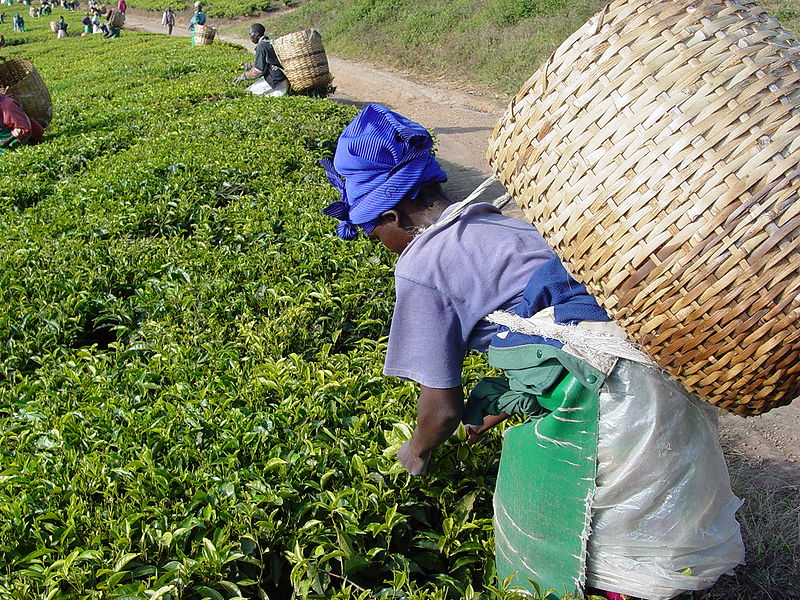
A lot of effort goes into tea production; decaffeination effectively throws out a large portion of that effort. Photo by Martin Benjamin, licensed under CC BY-SA 3.0.
When tea is decaffeinated, regardless of which process is used, both flavor and caffeine are extracted, not to mention the polyphenols that function as the antioxidants in tea and are responsible for some of tea’s health benefits.
Although some processes are more selective than others (in terms of extracting more caffeine relative to flavor), all processes remove significant amounts of flavor. What this means is that in order to produce a flavorful cup of decaffeinated tea, the initial tea leaf needs to be that much more flavorful. The efficiency of this production process is poor: decaf tea essentially involves putting energy and resources into producing a product, most of which is thrown out before consumption. (An exception to this, salvaging some of what is removed, is when the extracted caffeine is purified and sold to the pharmaceutical industry or beverage manufacturers; I don’t know if this is currently done with tea, although I’ve read of this being done for coffee.)
Furthermore, the decaffeination process is itself costly and energy-intensive. The CO2 process, generally considered the most desirable of the three processes mentioned above in terms of both safety and preservation of flavor, is particularly costly as it involves the use of supercritical carbon dioxide (i.e. compressed under great pressure). This is because, at regular atmospheric pressure, carbon dioxide transitions directly from a solid (dry ice) to a gas, without going through a liquid phase.
Natural Alternatives: Caffeine-Free Herbal Teas Which Resemble Black Tea in Flavor and Aroma
Rooibos: South African “Red Tea”
Rooibos is the herb that I see most frequently presented as being “tea-like”. It certainly is nowhere near as diverse as black tea, but it does share some characteristics, both of production and flavor and overall character, with black tea. Rooibos is one of the few herbal teas that is naturally oxidized, in a process analogous to how black tea is oxidized during production.
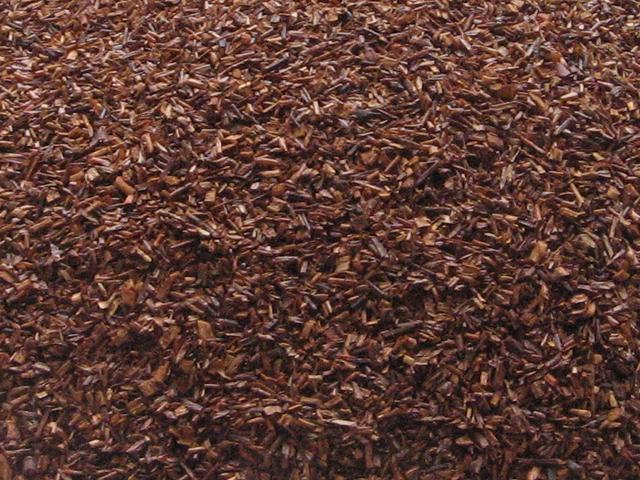
Rooibos, or South African “Red Tea”, is one of the herbal teas said to more closely emulate black tea.
I find that rooibos replicates the body, mouthfeel, and overall sensations on the palate of black tea more so than it emulates tea in aroma. There are certain earthy characteristics of aroma that rooibos shares in common with some black teas, but overall I find its aroma to be distinct. I find its aroma sometimes suggests vanilla, and while it has a fruitiness to it, the fruitiness seems more to suggest strawberry, in contrast to the grape, raisin, or stone fruit aromas suggested by some black teas. Perhaps more importantly to me, rooibos completely lacks the malty and floral tones that I like in a lot of black teas, and I find that its flavor profile tends to be muted–making it similar to some of the more muted black teas, but never like a strong Irish Breakfast or Assam, or even a sharper Darjeeling.
Red Raspberry Leaf
Red raspberry leaf is best-known as a women’s health product. Yogi Tea sells tea bags of this herb with the caption “Supports the female system“, a blurb I find amusing as I like to drink it as a beverage, and I certainly enjoy a strong female support system in my life. Medicinally, red raspberry leaf is typically consumed most during pregnancy, on the grounds that it supposedly strengthens or tones the uterus. However, several of my friends also swear by its effectiveness for PMS and menstrual cramps. As this is one area where I have no personal experience, and I was unable to find any studies backing up this use, the best I can give you is anecdotal evidence.
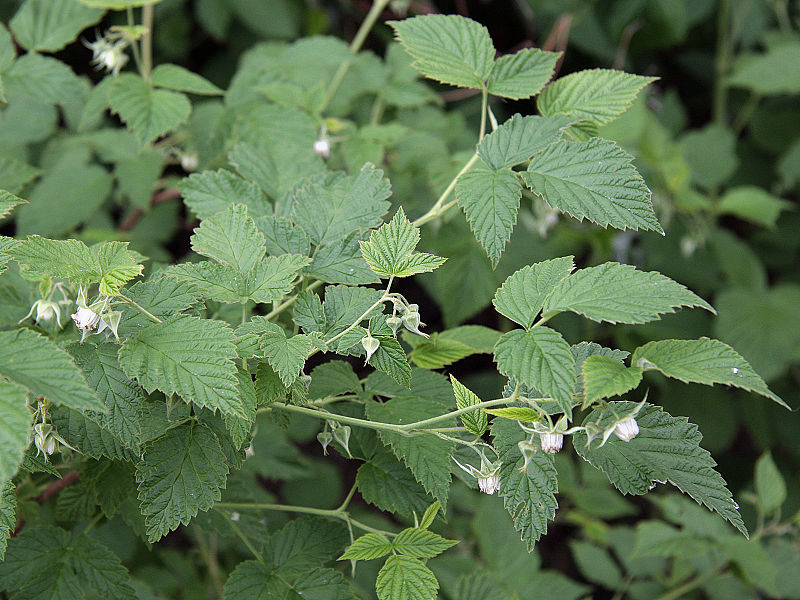
Leaves of the red raspberry plant, Rubus idaeus, can be used to make a caffeine-free herbal tea which in some respects resembles black tea. Public domain photo by Matti Virtala.
Unlike some women’s health teas (like lavender or honeybush), red raspberry leaf does not seem to alter hormone levels, and it is thus safe for both men and women to drink as a beverage. And drinking it as a beverage is something I not only do, but recommend, especially for people who want something that tastes like black tea–as I find this herb tastes a lot like black tea.
For starters, the color of the brewed cup is much more like a typical black tea, a rich brown color, than rooibos. Where the similarity really shows up, however, is in the aroma. It certainly doesn’t smell exactly like black tea, but I find that red raspberry leaf tea has an aroma that captures some of the floral tones in high-grade black teas. The tannins also seem to resemble black tea more than rooibos does. I would say raspberry leaf is probably most similar to a Ceylon, and possibly even some Darjeeling teas. The sensation on the palate, and mouthfeel though of this tea, is very different, I would say much less tea-like than rooibos. I find that it has a thinner body with a clearer feeling…and while there is an astringency that slightly resembles some of the more tannic teas, the astringency hits in a different way, I find coming more in the aftertaste and being a little less up-front than, say, in a strong breakfast tea or Assam.
New Jersey Tea: A Caffeine-Free Tea Substitute Native to Eastern North America
One herb that I’ve read about extensively, and have been itching to try, but have yet to actually get my hands on, is New Jersey Tea. New Jersey Tea, or Ceanothus americanus, is a plant in the buckthorn (Rhamnaceae) family. This plant family is distantly related to the rose family, and besides the namesake Buckthorns (small trees and shrubs), contains very few plants familiar to most residents of North America or Western Europe, although residents of the Western U.S. may be familiar with the snowbrush ceanothus, Ceanothus velutinus. Both the snowbrush ceanothus and New Jersey Tea were used by native Americans in herbal infusions to treat upper respiratory infections like the common cold and influenza.
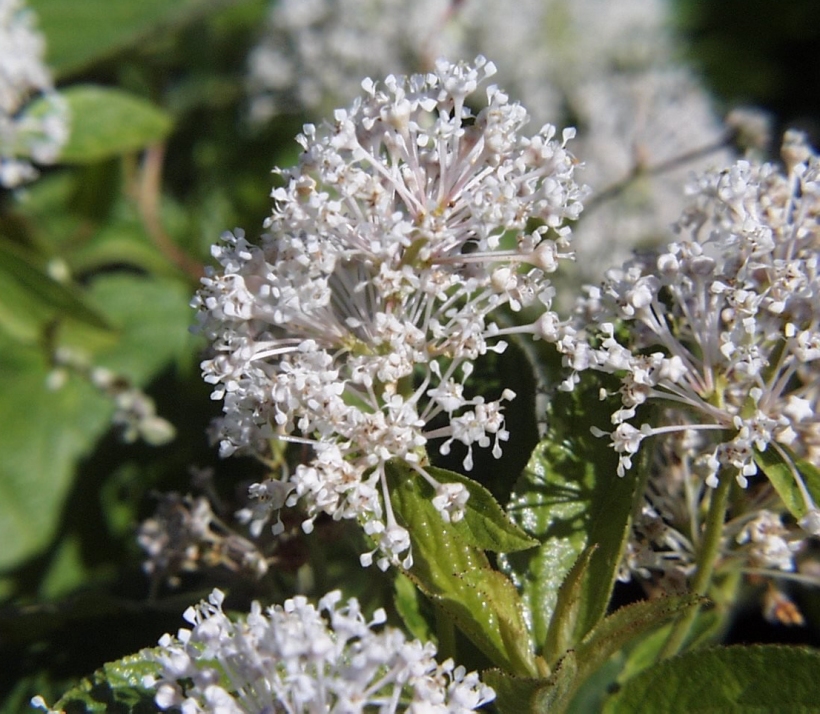
New Jersey Tea, Ceanothus americanus, in bloom. Public domain photo courtesy of the United States Fish and Wildlife Service, Sherburne National Wildlife Refuge.
I’ve also read that New Jersey Tea plant shares some aromatic components with wintergreen oil, and wintergreen tones are one of my favorite aromatic characteristics of high-quality black tea–and a quality that is captured in neither rooibos nor raspberry leaf. I have a feeling that I may really like this one when I finally try it.
And Now For Something Completely Different
Often, when I drink herbal tea, I don’t insist that my beverage resembles tea at all. Most of my favorite herbal teas taste nothing like black tea or any pure tea for that matter. Some of my favorite herbs to brew herbal teas with include spearmint, orange mint, tulsi, lemon balm, pineapple sage, and lemon verbena, to name a few. I also love the Monarda species, some of which resemble the bergamot flavoring in Earl Grey (without resembling the base black tea as much).
I’d take any of these herb teas over a decaf black tea any day. Sometimes I find that enjoying herbal teas on their own is more satisfying than trying to seek out ones that taste like black tea: although it’s possible to get close, it’ll never be possible to get an exact match, and I feel like herbal teas are easy to enjoy as a phenomenon in their own right.
What do you think?
- Do you ever feel the desire or need to avoid or limit your use of caffeine? Does the idea of a decaffeinated or caffeine-free tea-like beverage appeal to you?
- Have you ever found a decaffeinated pure tea that you really loved? I’m not talking flavored teas like Earl Grey, as the flavors can be added in after the decaffeination is carried out; I mean a straight tea like pure black tea.
- Are you concerned about the potential health issues surrounding the use of methylene chloride? Were you aware that this chemical is still in use in decaffeination processes?
- Have you tried any of the three examples I gave of naturally caffeine-free beverages that resemble black tea?
- Can you think of any herbal teas that I’ve missed, that you think would make a good addition to this list?
- When drinking herbal tea, do you seek out something tea-like, or are you more likely to go for something completely different?

November 15, 2013 at 9:52 am
I used to say I didn’t like herbal teas, and then I started drinking them the same way I drink black teas, with cream and sugar. My favorite caffeine free substitutes are red raspberry leaf and vanilla rooibos.
November 15, 2013 at 11:07 am
I definitely think vanilla blends well with rooibos…there’s something naturally vanilla-like about the aroma.
I think it makes sense too that if you like black tea with cream and sugar, you’d probably like herbal teas the same way. I definitely like my black tea straight, and I prefer my herbal teas the same way.
March 9, 2014 at 12:54 am
Thanks for taking the time to write this up, Alex. It’s very well done and has expanded my appreciation of teas. I am someone who is very caffeine sensitive and so have stopped drinking black and green teas at night. I tried to get the substance and body of black tea and followed your advice with rooibos – it is remarkably similar.
Like Sylvia, I am also adding milk and sugar, as with my black tea.
March 9, 2014 at 12:54 am
I should add that you also gave great advice on how to discern between decaf processes!
October 29, 2014 at 1:22 pm
Thank you!
April 21, 2014 at 2:34 pm
I’m with Sylvia. Can’t drink tea without milk and sweetener.
I have never come across a decaffeinated black tea that tastes very good. However, from what you say here, I wonder about adding red raspberry leaves or rooibos to decaffeinated black tea to get some of the flavor and feel of caffeine and tannins. Has anyone tried something like that?
Would love to know if you have tried New Jersey tea yet.
October 29, 2014 at 1:22 pm
It’s quite some time later, and I still haven’t gotten my hands on New Jersey tea…I would really like to though.
I definitely recommend trying out adding red raspberry leaf or rooibos to decaf tea; I’d be curious to hear how that turns out. You also could try blending rooibos and red raspberry leaf on their own.
May 25, 2014 at 11:26 am
Honeybush: http://shop.tgtea.com/HoneyPie-Loose-Leaf-Tea-001330-100/
Rooibos has a unpleasant aftertaste for me.
November 16, 2014 at 10:56 pm
Is there an easy way to find out what companies or producers use CO2 or ethyl acetate process to decaffeinate their teas?
November 17, 2014 at 2:41 pm
Unfortunately, no. The best bet in terms of a centralized resource is probably to check RateTea, look up the tea, and look on the page for the tea itself. For teas where we know which process is used, we’ve entered them in as CO2 decaf or Ethyl Acetate decaf. Unfortunately, even there the information will be very incomplete, so if you don’t find it there, you’ll need to contact the company in question.
Every decaf tea that I’ve entered into the site, I’ve searched for information about the decaffeination process used, but most companies don’t provide the info. There may be a few companies who have since added the info after I checked, but I did check each one manually when entering them.
We don’t currently have a search function for decaf processes on the site, but I just ran a search myself, manually, in the database, and I found only 1 Ethyl Acetate tea listed–Red Rose Decaf–but I found 59 teas with CO2 Processes. They are sold by Simpson & Vail, Arbor Teas, TeaGschwendner, Coffee Bean & Tea Leaf, Taylors of Harrogate, Numi, Choice Organic, and Adagio Teas. They aren’t listed on our site because no one has added them, but I also know that Upton Tea Imports sells (and advertises them as) both Ethyl Acetate and CO2 decaf teas.
Maybe this is something we could implement on the site, in the future, it wouldn’t be too much work to allow people to search by this.
I have not found a single company that advertises using methylene chloride, so no teas are listed with that process on the site.
December 1, 2017 at 9:47 am
Sometimes I find I get headaches within minutes of drinking decaf tea. I need to be careful of my overall caffeine content as i can start waking up with headaches if I have too much.